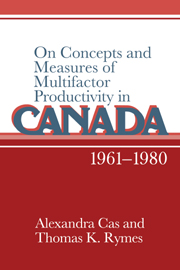Book contents
- Frontmatter
- Contents
- List of tables
- Acknowledgements
- Part I Introduction
- 1 Theoretical framework
- 2 An evaluation of the traditional and new measures of multifactor productivity
- 3 Some critical evaluations of the new measures
- Part II Measures of multifactor productivity, Canada, 1961–1980: Introduction to the experimental estimates
- Appendices
- Bibliography
- Name index
- Subject index
3 - Some critical evaluations of the new measures
Published online by Cambridge University Press: 11 September 2009
- Frontmatter
- Contents
- List of tables
- Acknowledgements
- Part I Introduction
- 1 Theoretical framework
- 2 An evaluation of the traditional and new measures of multifactor productivity
- 3 Some critical evaluations of the new measures
- Part II Measures of multifactor productivity, Canada, 1961–1980: Introduction to the experimental estimates
- Appendices
- Bibliography
- Name index
- Subject index
Summary
In this chapter, we set out the major conceptual difficulties confronting our new measures in ascending order of importance.
As will be outlined later, there are many problems in ascertaining, in constant prices, the gross outputs and intermediate inputs by industry. The new and traditional measures are expressed in this study in terms of quantities; we have not checked our estimates by expressing them, identically, in terms of rates of change of prices.
Many data difficulties and imperfections are common to both the new and traditional measures of multifactor productivity. Such common problems do not need reiteration in this chapter as they are dealt with in Part II.
Of particular relevance to the new measures is the problem of imported intermediate and capital goods and the measurement of quality change for reproducible inputs and outputs.
Imports
With respect to the problem of imports, some industries in Canada import intermediate inputs. Lacking input–output tables linked between Canada and its trading partners, we are at this stage unable to take account of the fact that such inputs are being produced abroad more efficiently over time.
- Type
- Chapter
- Information
- Publisher: Cambridge University PressPrint publication year: 1991



